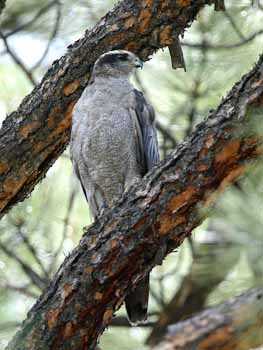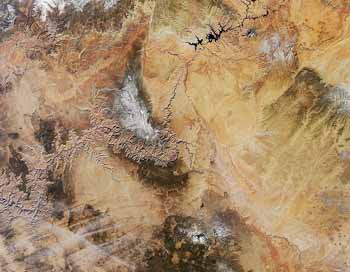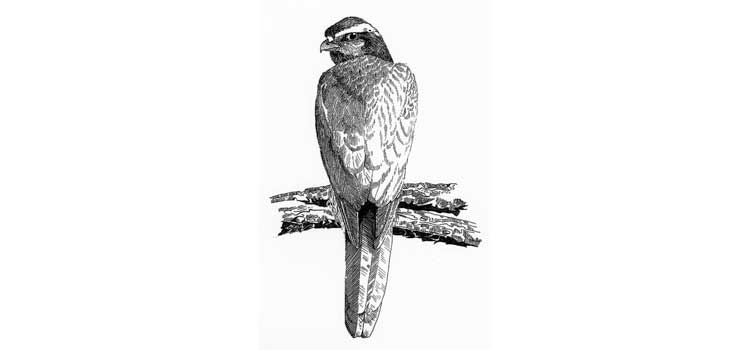OF NORTHERN GOSHAWKS AND KAIBAB
SQUIRRELS: THE LIFE HISTORY OF A
KEY PREDATOR AND ITS PREY ON THE
GRAND CANYON’S NORTH RIM
July 5-11, 2009
7 Days/6 Nights
Dr. Richard Reynolds and Dr. Marc Snyder
 The northern goshawk’s pursuit of the squirrel is a
fearsome blur, the final capture a marvel of unerring
and deadly precision. Even as the goshawk
relaxes the death grip of its talons, it’s the hunter’s
amazing eyes—large, red and glowing—that will
remain a lasting memory. Revered throughout
human history as a symbol of strength and power,
it is hardly surprising that the image of a northern
goshawk adorned the helmet of Attila the Hun—
or that in medieval Europe, goshawks were the
most prized of all falconry hawks. The northern goshawk’s pursuit of the squirrel is a
fearsome blur, the final capture a marvel of unerring
and deadly precision. Even as the goshawk
relaxes the death grip of its talons, it’s the hunter’s
amazing eyes—large, red and glowing—that will
remain a lasting memory. Revered throughout
human history as a symbol of strength and power,
it is hardly surprising that the image of a northern
goshawk adorned the helmet of Attila the Hun—
or that in medieval Europe, goshawks were the
most prized of all falconry hawks.
Viewed from the North Rim, the Grand Canyon is
a tortuous, deeply gouged rockscape cleaved by
an emerald green river, the Colorado, churning
away some 3,000 feet below. Undeniably, superlatives
come readily to mind when describing the
Grand Canyon. At Point Sublime, the bustling
tourist mecca of the Grand Canyon’s South Rim
lies but seven miles away as the raven flies—but a
world apart in every way. The North Rim is geographically
part of the Kaibab Plateau, a magnificent
landscape that harbors some of the most
uniquely beautiful remnants of pre-settlement,
old-growth ponderosa pine forest in the West.
Two species of extraordinary interest occur here:
the northern goshawk, one of the rarest of all raptors,
and the beautiful Kaibab squirrel, a silvery-tailed subspecies of the tassel-eared squirrel,
which has evolved in geographical isolation over
thousands of years. This remote area also serves
as the principal stronghold for a re-introduced
population of endangered California condors.
Wildlife biologist Richard Reynolds and a dedicated
team of researchers and volunteers recently
completed 18 years of ecological and habitat research
focused on the northern goshawk and its
food web—perhaps the most intensive study of a
raptor ever undertaken. Over 123 breeding pairs
of northern goshawks were identified, banded,
and monitored during the course of the study. To
understand the intricate relationship that exists
between the goshawk and its principal prey species,
biologist Marc Snyder joined the research
effort, focusing his efforts on the population ecology
and habitat requirements of tree squirrels and
the ways in which these herbivores have shaped
the genetic makeup of the forests on which the
goshawk depends. Kaibab squirrel, a silvery-tailed subspecies of the tassel-eared squirrel,
which has evolved in geographical isolation over
thousands of years. This remote area also serves
as the principal stronghold for a re-introduced
population of endangered California condors.
Wildlife biologist Richard Reynolds and a dedicated
team of researchers and volunteers recently
completed 18 years of ecological and habitat research
focused on the northern goshawk and its
food web—perhaps the most intensive study of a
raptor ever undertaken. Over 123 breeding pairs
of northern goshawks were identified, banded,
and monitored during the course of the study. To
understand the intricate relationship that exists
between the goshawk and its principal prey species,
biologist Marc Snyder joined the research
effort, focusing his efforts on the population ecology
and habitat requirements of tree squirrels and
the ways in which these herbivores have shaped
the genetic makeup of the forests on which the
goshawk depends.
 This exciting, hands-on field seminar exemplifies
the unique experiences that have become a Cloud
Ridge tradition. We’ll join the researchers in trapping
and banding adult goshawks (using mist nets
and live great horned owls as lures), assist with
tree rigging and climbing efforts to band juvenile
goshawks at their nests, help with visual surveys
of active nests and identify the presence of
previously-banded goshawks, learn to identify
optimal goshawk nesting and foraging habitat,
observe Kaibab squirrels and other prey species
that comprise the goshawk’s food web, and discuss
the major factors affecting prey abundance
(weather, masting in conifers, etc.). Our base
camp will be the U.S. Forest Service’s Big
Springs Ranger Station, located near Jacob Lake,
Arizona. We’ll also spend two nights camped at
Marble View Point, one of the most spectacular
settings on the Grand Canyon’s North Rim, taking
time to hike canyon rim trails and explore the
stunning forest ecosystems of the Kaibab Plateau.
We’ll examine the role of fire as a dynamic force
in forest ecology and discuss the science behind
the current strategies being proposed to manage
these forests—the ultimate test for the long term
survival of the northern goshawk. Don’t miss this
extraordinary opportunity to participate in the
most important goshawk research effort ever undertaken—
and the chance to explore the Grand
Canyon’s legendary North Rim! This exciting, hands-on field seminar exemplifies
the unique experiences that have become a Cloud
Ridge tradition. We’ll join the researchers in trapping
and banding adult goshawks (using mist nets
and live great horned owls as lures), assist with
tree rigging and climbing efforts to band juvenile
goshawks at their nests, help with visual surveys
of active nests and identify the presence of
previously-banded goshawks, learn to identify
optimal goshawk nesting and foraging habitat,
observe Kaibab squirrels and other prey species
that comprise the goshawk’s food web, and discuss
the major factors affecting prey abundance
(weather, masting in conifers, etc.). Our base
camp will be the U.S. Forest Service’s Big
Springs Ranger Station, located near Jacob Lake,
Arizona. We’ll also spend two nights camped at
Marble View Point, one of the most spectacular
settings on the Grand Canyon’s North Rim, taking
time to hike canyon rim trails and explore the
stunning forest ecosystems of the Kaibab Plateau.
We’ll examine the role of fire as a dynamic force
in forest ecology and discuss the science behind
the current strategies being proposed to manage
these forests—the ultimate test for the long term
survival of the northern goshawk. Don’t miss this
extraordinary opportunity to participate in the
most important goshawk research effort ever undertaken—
and the chance to explore the Grand
Canyon’s legendary North Rim!
Price: $1,350 (includes a $500 deposit)
Group Size: 16
Trip Rating: 3
Price Includes: all instruction and instructional
materials, USFS and NPS camping fees and entrance
permits as required, use of hot showers and
other amenities at the Big Springs Ranger Station,
16 gourmet camping meals provided by your
Cloud Ridge chefs, and all transport in 4WD vehicles
to the field areas.
Does not include transportation
to or from the Big Springs Ranger Station
from your point of departure, basic camping
equipment (tent, sleeping bag, and pad), or meals
other than those listed. We recommend that anyone
not wishing to drive the entire distance take
advantage of the inexpensive flights to Las Vegas
and rent a car at the airport for the two-hour drive
south.
The seminar begins at 4 pm on July 5
(Sunday) at the Big Springs Ranger Station and
concludes with your departure for home on the
morning of July 11 (Saturday). |
